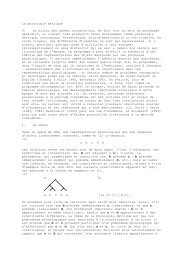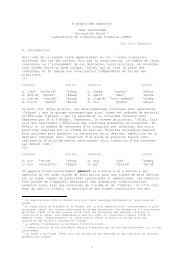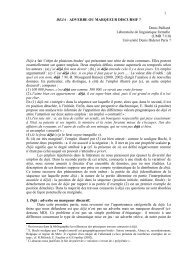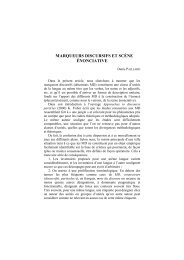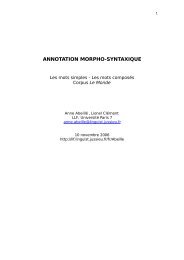CV as the only syllable type Jean Lowenstamm
CV as the only syllable type Jean Lowenstamm
CV as the only syllable type Jean Lowenstamm
Create successful ePaper yourself
Turn your PDF publications into a flip-book with our unique Google optimized e-Paper software.
young branch", illustrate similar behavior.<br />
(16) Feminine palatalization of a-final Imperatives<br />
Root m<strong>as</strong>c. fem.<br />
a. √qTA qITa qICä<br />
b. √xdA xIda xIjä<br />
c. √b w kA b w Ika b w Ik y ä<br />
d. √gfA gIfa g y Ifä<br />
e. √kbA kIba k y Ibä<br />
f. √smA sIma simä *šImä<br />
g. √dfA dIfa difä *jIfä<br />
h. √brtA bärta bärcä<br />
i. √qrbA qämba q y ämbä<br />
The careful reader will have noticed that a corollary always accompanies<br />
palatalization, viz. centralization into ä of <strong>the</strong> final a. Thus, M<strong>as</strong>culines are<br />
always a-final, where<strong>as</strong> Feminines are always ä-final. This change of a to ä,<br />
subsequent to Palatalization, is <strong>the</strong> central point of this section. However, before<br />
it can be addressed, one l<strong>as</strong>t piece of information h<strong>as</strong> to be adduced regarding <strong>the</strong><br />
representation of palatalization. I argue in <strong>Lowenstamm</strong> (in preparation) that<br />
Chaha palatalization does not exclusively affect a segment of <strong>the</strong> root tier, a<br />
scenario represented in (17a). Ra<strong>the</strong>r, <strong>the</strong> palatalizing agent, I, claims a<br />
consonantal position of its own to <strong>the</strong> right of <strong>the</strong> palatalized segment. That is, a<br />
palatalized consonant is, for all intent and purposes, a cluster, <strong>as</strong> shown in (17b).<br />
(17)<br />
a. b.<br />
... C V C ... ... C V C ...<br />
| | |<br />
{dI Fem } {d I Fem }<br />
[...j...]<br />
[...j...]<br />
Consider now <strong>the</strong> fairly straightforward c<strong>as</strong>e of <strong>the</strong> derivation of a<br />
M<strong>as</strong>culine/Feminine alternation such <strong>as</strong> [qITa] (18a) vs. [qICä], <strong>the</strong> ingredients<br />
of which appear in (18b).<br />
(18)



